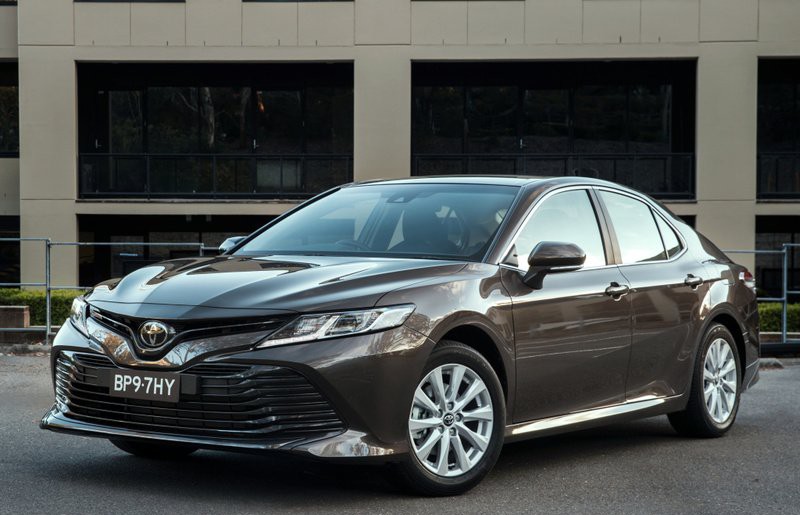Toyota Camry 2017 2.0 petrol description
Sedan Toyota Camry 2017 2.0 is being produced from 2017. It has four-cylinder petrol engine with displacement of 2.0 litres, which produces power of 150 horsepower on 6500 rpm and torque 199 Nm (Newton metres) on 4600 revolutions per minute.
This 4-cylinder 16-valve engine camshaft is driven by chain (What is an engine chain and belt? ). Engine has fuel injection system without turbocharger. Engine versions compliant with Euro 4 and Euro 5 emission standards available. Average engine life expectancy (mileage before serious repairs are needed) is from 220 000 to 370 000 kilometres. Note that engine life can be longer or shorter depending on maintenance.
More engine specs
Owners often report increasing oil consumption, which becomes particularly pronounced over time. Additionally, the water pump has a limited ...
This Toyota Camry 2.0 engine oil type is 5W-20 and oil capacity is 4.2 litres.
Toyota Camry 2017 2.0 has front wheel drive (FWD) and automatic gearbox with 6 gears.
Toyota Camry 2017 2.0 accelerates to speed 100 kilometres per hour in 10.4 seconds. The maximum speed of this car is 210 km/h.

Toyota Camry 2017 2.0 technical data
| Model: | Toyota Camry 2.0 | ||
|---|---|---|---|
| Body style: | Sedan | ||
| Production period: | 2017. January | ||
| Engine: | 1998 cm3 Petrol, 4 cylinders | CO2 emissions: | 168 g/km |
| Power: | 150 HP ON 6500 RPM | Torque: | 199 NM ON 4600 RPM |
| Gearbox: | Automatic gearbox (6 gears) | Drive type: | Front wheel drive (FWD) |
| Maximum speed: | 210 km/h | Acceleration 0-100 km/h: | 10.4 seconds |
| Fuel consumption (l/100km): | no data 10.0 (urban) | ||
| Fuel tank capacity: | 60 litres (15.9 gallons) | ||
| Car dimensions: | 4.89m (length) 1.84m (width) 1.45m (height) | ||
| Turning diameter: | 11.4 meters | ||
| Trunk capacity: | 493 litres | ||
Toyota Camry 2017 2.0 engine 3ZR-FE
Engine reliability and common problems:
Owners often report increasing oil consumption, which becomes particularly pronounced over time. Additionally, the water pump has a limited service life, and after 150,000 km, the timing chain tends to stretch, causing increased noise that can only be resolved by replacing the component. Strange noises during engine operation are another frequent complaint.Carbon deposits in the intake manifold and throttle body often lead to fluctuating idle, while regular oil leaks typically originate from the oil filter or the timing chain cover gasket.
Some key issues with the engine include that repairs are often impossible or not economically viable. Strong vibration at idle, which cannot be resolved by replacing the engine mounts, is a design feature. Poor cold starts and noise in the timing mechanism occur, requiring attention to fuel quality and timely filter replacement. Performance issues during startup can often be fixed by resetting the control unit. Low-quality fuel leads to rapid clogging of fuel filters, and poor-quality oil contributes to the failure of hydraulic lifters. Valve seals wear out quickly, requiring regular replacement to maintain functionality.
Overall, this engine can last around 220,000 to 370,000 km if properly maintained, using the correct quality oil and fuel, and carrying out regular checks and maintenance.
The engine has hydraulic valve tappets (lifters), which provide quieter operation and do not require periodic adjustment, but are more complex in design and can cause serious engine damage in the event of failure.
| Engine displacement | 1986 cm3 |
|---|---|
| Number of cylinders | 4 |
| Bore (cylinder diameter) | 80.5 mm |
| Stroke length (piston move) | 97.6 mm |
| Compression ratio | 10 : 1 |
| Camshaft drive | Timing chain Chain motors are considered more reliable, chain replacement usually is required less often than a timing belt, but they are often louder and vibrate more. |
| Fuel system | Injection |
| Toyota Camry 2017 2.0 oil type | 5W-20 |
| Oil capacity | 4.2 litres (4.4 quarts) |
| Power | 140 - 150 HP ON 6500 RPM |
| Torque | 190 - 200 NM ON 4600 RPM |
| Start of production (year) | 2007 |
| Duration of production | 18 years |
| Engine also used on | Toyota Avensis Toyota RAV4 |
Generally, the use of an engine in several models and its long production run is an indication of the quality of the engine and the success of its design. |
Most often compared to
All Toyota Camry sedan [2017 modifications
| Modification | Engine | Power | Consumption |
|---|---|---|---|
| Toyota Camry 2017 2.0 | 2.0 Petrol | 150 HP | - |
|
Toyota Camry 2017 2.5
Most fuel efficient version |
2.5 Petrol | 181 HP | 8.3 l/100km |
|
Toyota Camry 2017 3.5
Most dynamic version - 100 km/h in 7.7 seconds |
3.5 Petrol | 249 HP | 8.7 l/100km |
